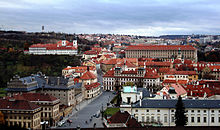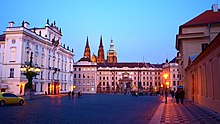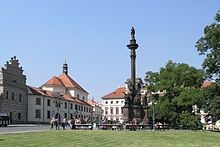Hradčany (Prague)
| Hradčany | |||
|---|---|---|---|
|
|||
| Basic data | |||
| State : |
|
||
| Region : | Hlavní město Praha | ||
| Municipality : | Praha | ||
| Administrative district : | Prague 1 , Prague 6 | ||
| Area : | 152 ha | ||
| Geographic location : | 50 ° 5 ' N , 14 ° 24' E | ||
| Residents : | 1,793 (December 31, 2015) | ||
Hradčany (German: the Hradschin ; meaning in German: castle town or place near the castle ) is a cadastral municipality of the Czech capital Prague . The castle town to the west of Prague Castle was one of the four Prague cities until 1784.
Surname
In German, in contrast to Czech, it has become misleadingly common to understand “Hradschin” to mean Castle Hill or, indirectly, Prague Castle. Matthäus Merian cites the original meaning: “... on the other side there is a hill or mountain, on which the town of Hradezan / Hraczinum, or as it is commonly called, Hratschin, which is also called the Upper City of Prague, according to its mayor and Rath, also has its own city book. "
history


The district of Hradčany adjacent to the castle was probably founded in 1320 by the burgrave Hynek Berka of Dubá as the third Prague city after the Old Town and the Lesser Town . Unlike the other Prague cities, however, it was not a free city, but was subordinate to the burgraves (until 1598). Initially, the settlement had only the space around the Hradcany Square (Hradčany) taken. Under Charles VI. the city was expanded and included in the common wall ring with the Lesser Town.
After a devastating fire in 1541, the city experienced a complete redesign with the construction of palaces for the clergy (archbishop and canons) and the nobility. Important Bohemian aristocratic families like the Salms , Schwarzenbergs , Czernins , Sternbergs and Lobkowitz built their magnificent palaces here. Only the layout of the market or square itself remained largely unchanged. The Hradschin was made a royal city by Rudolf II in 1598 .
Fire Place (Pohořelec) was the suburb of the city Hradčany. It was founded in 1375 by the burgrave Aleš z Malkovic. It got its name from the numerous fires, especially the three large conflagrations in 1420, 1541 and 1742. Its current appearance is predominantly determined by the baroque .
In the 18th century the Hradschin was united with the city of Prague. In 1991 the district had 2797 inhabitants. In 2001 it consisted of 212 houses in which 2313 people lived.
Attractions

Around the Hradschiner Platz with a baroque Marian column and the monument to Tomáš Masaryk are the main entrance of the Prague Castle, the Archbishop's Palace , the Schwarzenberg Palace and a number of other aristocratic palaces. There are numerous beautiful gardens under the castle .
The Loreto Square (Loretánské náměstí) emerged from 1703 to 1726, when the noble family Černín who bought previously reported here houses, pay off and let redesign the square. The mighty Černín Palace , today the seat of the Czech Foreign Ministry, stands slightly elevated with its 150 m long main front. Opposite is the Prague Loreto . The Capuchin monastery forms the end of the square.
Immediately west of the Hradschin is the Strahov Monastery , which is no longer part of the Hradschin.
literature
- Tomáš Durdík : Osídlení 12.-13. století v severním předpolí Pražského hradu. (Settlement of the northern apron of Prague Castle in the 12th-13th centuries.) Archeologické Rozhledy 30, 1978, pp. 440–443.
- Jan Frolík / Katařina Tomková: Západní předpolí Pražského hradu - Hradčany a jejich archeologický výzkum v nejnovějším období. (The western apron of Prague Castle - the city of Hradschin - and its recent archaeological research.) Archeologické Rozhledy 49, 1997, pp. 65–71.
- Umělecké památky Prahy 4. Pražský hrad a Hradčany. Praha 2000, ISBN 80-200-0832-2 .
- Jaroslav Schaller: Description of the royal capital and residence city of Prague together with all the interesting sights. : The city of Hradschin, or the IVth main district of Prague . Prague: Geržabeck, 1794
Web links
Individual evidence
- ↑ Matthäus Merian: Topographia Bohemiae, Moraviae et Silesia , 1650, p. 59



